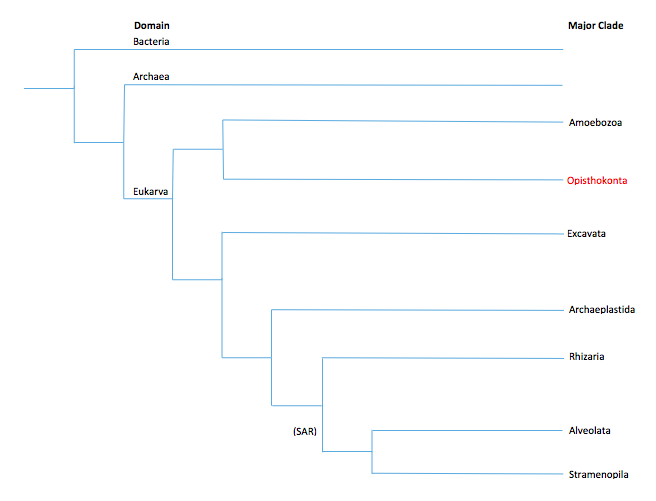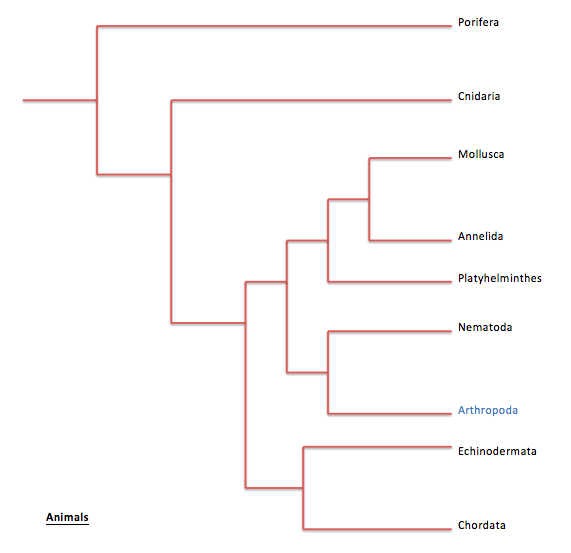Classification
Domain: Eukarya
Eukaryotes (for example,
Alabama cave shrimp and
popcorn flowers) have nuclei and membrane-bound organelles.
Endosymbiotic theory states that their mitochondria arose from
endosymbiosis with a bacterium. This idea is well supported in
that all cells within eukaryotes have mitochondria with a
remnant genome that is similar to heterotrophic gram-negative bacteria (characterized by cells that have two
membranes and a cell wall in the space between the membranes).
Kingdom: Animalia
Animals such as the
star-nosed mole and the
giant silkworm caterpillar are multicellular and heterotrophic organisms that are
motile and lack structural cells. Most animals exhibit bilateral
symmetry and are triploblastic (have
three types of tissues - the ectoderm that gave rise to
skin and nervous tissue; the endoderm that gave rise to the
digestive tract; and the mesoderm that gave rise to muscle,
bone, and the circulatory system), though poriferans display
asymmetry and have no true tissues, and cnidarians exhibit
radial symmetry and are diploblastic (have two types of
tissues - the ectoderm and the endoderm). Most animals also
ingest food and digest it in an
internal cavity (ADW 2014).
Phylum: Arthropoda
There are more species of arthropods, including the
California night-stalking tiger beetle and the
horse bot fly, than if one were to sum all
other phyla (ADW 2014). They have strongly
segmented bodies that allow for specialized body regions, or
tagmata, that include the head, thorax, and abdomen (ADW 2014).
Arthropods have exoskeletons made of chitin that provide an
external covering for support, protection, and locomotion. They
are protective in that they deter predators and are enhanced for
camouflage. Arthropod exoskeletons do not grow with the
organisms, so ecdysis, or molting, is required for growth. They
have
open circulatory systems that contain a heart, arteries,
and the open spaces of the hemocoel (ADW 2014).
Class: Insecta
There are over one million named species of insects, like the
devastating grasshopper; thus, they
comprise a great majority of the earth's animal species (ADW 2014). They are located in many habitats, both
terrestrial and freshwater. The
shape and form of insects vary
widely; however, no insect has a very large body size (ADW
2014). Insects have two pairs of wings that are formed from
outgrowths of the body wall, which is quite unlike how any
vertebrate wings are formed, as well as three pairs of walking
legs (ADW 2014). Gases are carried to metabolizing tissues
through spiracles - external openings - and finely-branched
tubules (ADW 2014).
Order: Hymenoptera
The third largest order of insects, the Hymenoptera are
ecological specialists that have thus had much success as a
taxon; one representative of this order is the
blue-black spider wasp (GE 2009). It is the only order besides
the Isoptera, which includes the termites, that has evolved
complex social systems in which there is a division of labor (GE
2009). Most of the Hymenoptera have two pairs of wings that
operate together and are linked together by hooks called hamuli
along the leading edge of the hind wings (GE 2009). Females in
the Hymenoptera develop from fertilized eggs, while males
develop from unfertilized eggs; whether or not an egg is
fertilized is dependent on the females, who can thus regulate
the sex ratio of offspring (GE 2009).
Family: Formicidae
Ants such as the
black carpenter ant are placed in this single family (ADW
2014). Most formicids have a metapleural gland that produces
phenylacetic acid that helps fight against problematic fungi and
bacteria (ADW 2014). Ants are distinct from other insects in
that they have a waist that is pinched down posteriorly at the
abdomen (ADW 2014). Formicids have a
complex social system
similar to termites, bees, and wasps in that adult ants care for
the young as a result of the coexistence of two or more
generations, and castes are implemented in which there are
reproductive queens and kings, and sterile workers (all female)
(ADW 2014).
Genus: Pogonomyrmex
More than 70 species are contained within this genus
(Pogolumina 2010). All of these ants are located solely in the
western hemisphere from southern Canada to the southernmost tip
of South America. All 25 species in North America, north of
Mexico, are located west of the Mississippi River except for one
species - P. badius (Pogolumina 2010).
"Pogos," as the genus is often shortened to, are quite important
in plant communities as a result of their acts of seed
harvesting and seed dispersal (Pogolumina 2010). Many Pogos are
quite aggressive,
always prepared to sting to defend both the
nest and themselves (Pogolumina 2010).
Species: Pogonomyrmex californicus
(Named for the beard-like structure called the
psammophore that
is located below the head, as well as its prevalence in
California [Pogolumina 2010].)
This ant within the genus Pogonomyrmex is primarily
found in dry and arid desert regions in the United States and
Mexico (De Vita 1979). It
tends
to forage individually, unlike many other ants within the
same genus. This ant is well-known for its
powerful sting; in fact,
native peoples have used its venom as a
hallucinogen (Groark 1996).

Figure 1. Domain and major clade phylogenetic tree.
The phylogenetic tree above displays the
relative placement of Pogonomyrmex californicus within the
major clades of the domain Eukarya (Figure 1; Campbell et al. 2008).
The California harvester ant is a
member of major clade Opisthokonta, just as the
common dolphin is, because its sperm has
posterior flagella, and its mitochondria contains flat cristae
(folds in the inner membrane).

Figure 2. Phyla of kingdom Animalia phylogenetic tree.
The phylogenetic tree above displays the
relative placement of Pogonomyrmex californicus within the
phyla of the kingdom Animalia (Figure 2; Campbell et al. 2008). The California harvester ant
is a member
of the phylum Arthropoda because it has tagmata and an exoskeleton
made of chitin that provides an external covering for support,
protection, and locomotion, as mentioned above (ADW 2014).